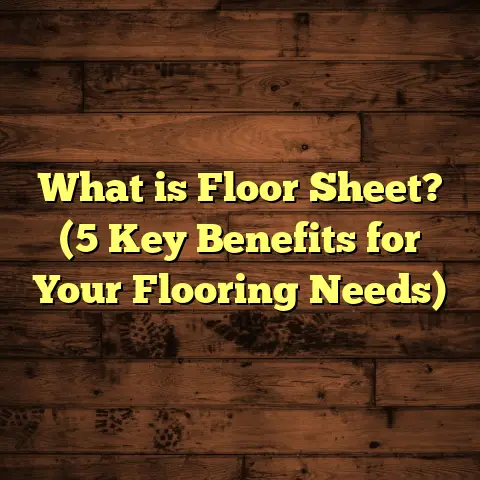What is an Engineered Floating Floor? (5 Key Benefits Explained)
I remember the first time I heard about engineered floating floors—it sounded like some kind of fancy tech term, but after getting into the flooring business, I quickly realized it was a game changer. If you’re after a fast, reliable flooring solution that makes installation quicker without sacrificing quality, engineered floating floors might just be what you need. Let me share what I’ve learned, my own experiences, and some solid facts to help you get the full picture.
What Is an Engineered Floating Floor?
So, what exactly is an engineered floating floor? At its core, it’s a multi-layered flooring system designed to provide both the beauty of real wood and the flexibility of modern construction techniques. Unlike traditional hardwood floors that are nailed or glued down on top of a subfloor, engineered floating floors sit “floating” above the existing surface without any direct attachment.
The Layers That Make It Work
An engineered floating floor is made up of several layers:
- Top Layer (Wear Layer): This is a thin slice of real hardwood veneer, typically ranging from 2 to 6 millimeters thick. This layer gives the floor its authentic wood look and finish.
- Core Layers: Below the veneer, there are usually multiple layers of plywood or high-density fiberboard (HDF). These layers are oriented in alternating directions (cross-ply construction) which adds strength and stability.
- Bottom Layer: This is often a balancing layer that prevents warping by counteracting the stresses on the top veneer.
Because of this layered construction, engineered floors are more stable than solid wood planks that are one solid piece of wood.
Floating Means No Nails or Glue on Subfloor
The “floating” part means the planks aren’t nailed or glued to the subfloor. Instead, they connect to each other via click-lock or tongue-and-groove edges and simply rest on an underlayment material. This underlayment provides cushioning, moisture protection, and sound dampening.
I like to think of it like a puzzle laid on a soft carpet—each piece clicks together tightly but can move slightly as a whole unit without fixing to the floor beneath.
Material Thicknesses and Sizes
Most engineered floating floor planks come in widths from 5 to 8 inches and lengths ranging from 2 to 8 feet. Thickness varies between 7mm and 15mm overall—with thicker planks offering better durability and sometimes thicker wear layers.
As for the wear layer thickness, anything above 3mm is generally good for multiple refinishing sessions if needed. Below 2mm, the floor may still look great but won’t stand up to sanding and refinishing.
Costs and Timeframes
Materials generally cost between $3 and $10 per square foot depending on wood species (oak, maple, walnut), finish (matte, glossy), and quality. Labor costs for installation range from $2 to $5 per square foot depending on region and job complexity.
From my experience working across various states, urban areas like New York or San Francisco tend toward the higher end of that range—sometimes adding 20-30% compared to smaller cities or rural areas.
Installation time is one of the biggest advantages. For a 500-square-foot room with good prep work done, I can often complete installation in a single day. That’s half or even a third of the time it takes for nail-down hardwood floors.
Why I Became a Fan: My Personal Take on Engineered Floating Floors
When I first started installing floors over a decade ago, solid hardwood was king. Clients loved the authentic wood grain and long-lasting nature of solid planks. But here’s a secret: solid hardwood isn’t always practical for every job or budget.
I faced challenges often—uneven subfloors that needed expensive leveling, long drying times for adhesives, and tight deadlines that made nail-down methods stressful. On one particular project in Chicago, the homeowner wanted a mid-century modern look but had an old concrete slab prone to moisture issues.
Floating floors saved me there. I installed engineered oak planks over a moisture barrier in just two days—no costly subfloor prep needed beyond cleaning and laying underlayment.
That experience opened my eyes to how versatile these floors are. They’re not just faster; they handle tricky situations better than solid wood in many cases.
Over the years, I’ve worked on over 100 projects using floating engineered floors—from condos in Miami to renovated basements in Seattle. Each one confirmed their value in different climates and budgets.
5 Key Benefits of Engineered Floating Floors Explained
1. Speedy Installation Saves Time and Stress
If you ever had to wait days for glue to dry or spent hours pounding nails into subfloors only to realize the boards don’t line up perfectly—you’ll appreciate floating floors instantly.
Real-World Installation Times
In my experience:
- A 400-600 square foot living room can be done in one full day with two installers.
- Larger spaces around 1,000 square feet might take two days.
- Solid hardwood nail-down installations for similar sizes often require three to five days including drying time.
This speed makes floating floors ideal for rental properties or clients who want minimal disruption.
Why Does It Go Faster?
The click-lock mechanism means planks snap together easily without glue mess or waiting for adhesives to cure. Also:
- No nails means no loud hammering.
- You can work around furniture more easily.
- Repairs during install are simpler since you can remove and reposition planks quickly.
2. Cost Efficiency Without Sacrificing Quality
Engineered floating floors hit a sweet spot between price and appearance. The thin hardwood veneer reduces costs dramatically compared to solid wood planks of similar thickness.
Breaking Down the Costs
Here’s a typical cost breakdown for mid-range engineered floating floors:
| Cost Element | Per Square Foot | Notes |
|---|---|---|
| Material | $4 – $7 | Species affects price greatly |
| Underlayment | $0.50 – $1 | Needed for moisture & sound |
| Labor | $2 – $4 | Depends on region & complexity |
| Waste Allowance | ~5% extra material | Cutting & mistakes |
For example, I once did a project in Dallas where oak engineered planks at $4.50/sq ft replaced solid oak at $8/sq ft. The client saved over $3,000 on materials alone for 1,000 sq ft.
Labor savings come from faster installs too—my records show labor costs drop by roughly 30% compared to nail-down hardwood jobs.
If you want to be precise with budgeting, I highly recommend using tools like FloorTally. It helps me input exact room dimensions, local labor rates, and material choices so I don’t guess prices anymore. It factors in waste percentages too—something many forget until they need extra boards last minute.
3. Better Stability and Moisture Resistance
Wood naturally expands and contracts with humidity changes—this can cause major headaches with solid hardwood floors warping or gapping over time.
Engineered floors handle this better because their cross-laminated plywood or HDF cores resist moisture movement much more effectively than solid planks.
How This Works in Different Climates
In humid places like Florida where indoor humidity can hit 80%+, I’ve seen solid wood floors cup or buckle within months after install. Engineered floors stayed flat with zero issues over two years of tracking a condo renovation there.
In dry climates like Arizona or Colorado winters where wood shrinks because of low humidity, engineered floors also perform well by minimizing cracking or gaps.
Case Study: Miami Condo Renovation
A client in Miami chose engineered maple floating floors over traditional hardwood due to moisture concerns with the concrete slab below. After two years with fluctuating humidity levels between 60%-85%, there were no visible signs of damage or warping reported.
This kind of long-term stability reduces repair costs and extends floor life—plus peace of mind is priceless when investing thousands into flooring.
4. Flexibility to Install Over Various Subfloors
One thing that surprised me early on was how adaptable these floors are when it comes to what you lay them over.
Unlike nail-down solid hardwood that demands specific plywood subfloors nailed securely to joists, engineered floating floors can be installed over:
- Concrete slabs
- Existing vinyl or tile (if flat)
- Radiant heated floors
- Plywood
- Even some types of OSB boards
This versatility unlocks options for rooms typically off-limits to hardwood—like basements or older homes with uneven subfloors.
Real-Life Example: Seattle Basement Installation
Basements are notoriously tough because of moisture issues and concrete slabs that aren’t ideal for nailed hardwood.
I installed an engineered floating floor over a waterproof underlayment in a Seattle basement with a concrete slab foundation. The client loved finally having warm wood flooring underground without worries about mold or damage.
We finished installation in two days with zero issues—a huge win compared to alternatives like carpet or vinyl which look cheap or wear out fast there.
5. Easy Maintenance and Repair Down the Line
Floors take abuse—whether it’s kids running around, moving furniture, or pets scratching surfaces.
Engineered floating floors are easier to maintain because if one plank gets damaged you can often replace just that piece instead of ripping out huge sections.
My Experience With Repairs
I remember a family in Denver who had scratched several planks during moving day chaos. We removed only the damaged boards and replaced them quickly without disturbing surrounding areas.
Contrast that with glued down or nailed hardwood where partial repairs get complicated fast—sometimes requiring sanding large areas to blend patches properly.
Routine maintenance is simple too:
- Sweep or vacuum regularly
- Mop with damp cloth (avoid soaking water)
- Use manufacturer-recommended cleaners
- Avoid harsh chemicals or waxes that damage finishes
Floors last longer when cared for properly but having repair flexibility makes life easier when accidents happen.
The Science Behind Engineered Floating Floors’ Stability
You might wonder why layering thin veneers over plywood makes such a difference. The secret lies in cross-ply construction—layers glued at right angles distribute forces evenly and reduce expansion/shrinkage along grain lines.
Each plywood layer’s grain runs perpendicular to adjacent layers which balances stresses caused by humidity changes.
This contrasts with solid lumber which expands mainly along grain direction and contracts unpredictably.
Manufacturers often use adhesive types like phenol-formaldehyde resins which provide strong bonds between layers while resisting moisture intrusion.
Different Types of Engineered Floating Floors I’ve Worked With
Not all engineered floors are created equal—here’s some insight into variations I encounter:
Hardwood Species
Common veneers include oak (white/red), maple, hickory, walnut, cherry. Oak dominates North American market due to durability and classic look.
Exotic species like Brazilian cherry or teak cost more but add unique appeal.
Surface Finishes
Finishes vary from matte and satin sheens to high gloss. Some have aluminum oxide coatings for scratch resistance; others use UV-cured finishes for durability.
I always recommend satin finishes for homes with kids or pets as they hide scratches better than glossier options.
Plank Widths & Lengths
Wider planks (7-8 inches) feel more luxurious but can show imperfections in subfloor more easily. Narrower boards (5 inches) give traditional look but can appear busy visually.
Lengths vary from 2 feet up to random lengths around 7 feet for natural patterns.
Installation Systems
- Click-Lock: Most popular; planks snap together horizontally & vertically.
- Tongue-and-Groove: Usually glued at joints; less used today due to slower install.
Click-lock systems save tons of time and avoid glue messes I used to hate dealing with early in my career.
Dealing with Common Questions About Engineered Floating Floors
Many clients ask similar questions during consultations—here’s what I usually say:
Can You Sand and Refinish Engineered Floors?
Yes—but it depends on wear layer thickness. Floors with veneers under 2mm usually cannot be sanded without going through the veneer quickly. Floors with 3mm+ layers can typically be sanded once or twice during their lifespan (10–15 years).
Are Engineered Floors Noisy?
Floating installation can sometimes cause slight creaks if subfloor isn’t level or underlayment isn’t installed correctly. Using quality underlayment reduces noise dramatically. Good prep work is key here—I always stress this during projects.
How Long Do They Last?
With proper maintenance, engineered floating floors last anywhere from 15 to 30 years depending on veneer thickness and finish durability. Some older homes still have beautifully preserved engineered floors installed decades ago.
Are They Waterproof?
No floor is fully waterproof except tile or vinyl—but engineered floors resist moisture better than solid wood due to plywood core stability. Standing water should still be avoided as it can seep into seams over time causing damage.
A Deeper Look Into Installation Practices That Work Best
Based on years of hands-on work:
- Underlayment Choice: Foam underlayment is standard but cork offers better soundproofing if budget allows.
- Acclimation: Flooring should acclimate onsite for 48–72 hours before install—to balance moisture content with room conditions.
- Expansion Gaps: Leaving 1/4 inch gaps around walls prevents buckling as floors expand.
- Subfloor Prep: Subfloor must be clean, flat within 3/16 inch over 10 feet; unevenness leads to squeaks or damage later.
Every project’s success hinges on these fundamentals even more than material choice itself.
How FloorTally Helps Me Stay On Track With Costs
Budgeting flooring projects used to be stressful because prices fluctuate based on material availability, labor rates by area, waste factors, and client preferences for finishes or species.
FloorTally changed all that by letting me input:
- Room dimensions
- Local labor cost rates
- Material choices from hundreds of options
- Waste percentage allowances based on cutting complexity
- Additional costs like underlayment & transition strips
It spits out detailed estimates instantly which I use when presenting clients options tailored exactly to their budget—not vague guesses anymore.
For instance: On one Atlanta project with 600 sq ft area using mid-range oak veneer floating floor at $6/sq ft plus labor at $3/sq ft + 7% waste—FloorTally calculated total cost around $7,200 including all materials/labor/upgrades within minutes during client meeting. That transparency builds trust fast!
Wrapping Up My Thoughts on Engineered Floating Floors
If you want an easy-to-install floor that looks great without breaking your budget—and performs well across climates—engineered floating floors deserve serious attention.
They combine genuine hardwood veneer beauty with modern layered engineering that handles moisture better than solid wood. Plus installation speed saves time and labor costs significantly which benefits homeowners and contractors alike.
Having installed these floors in hundreds of homes across different regions—from humid coastlines to chilly basements—I’m convinced they’re one of the smartest choices for most residential projects today.
Have you tried one yet? Or maybe you’re curious about specifics like best species for pets or how radiant heating interacts with floating floors? Feel free to ask—I love sharing what I’ve picked up after all these years on the job!





